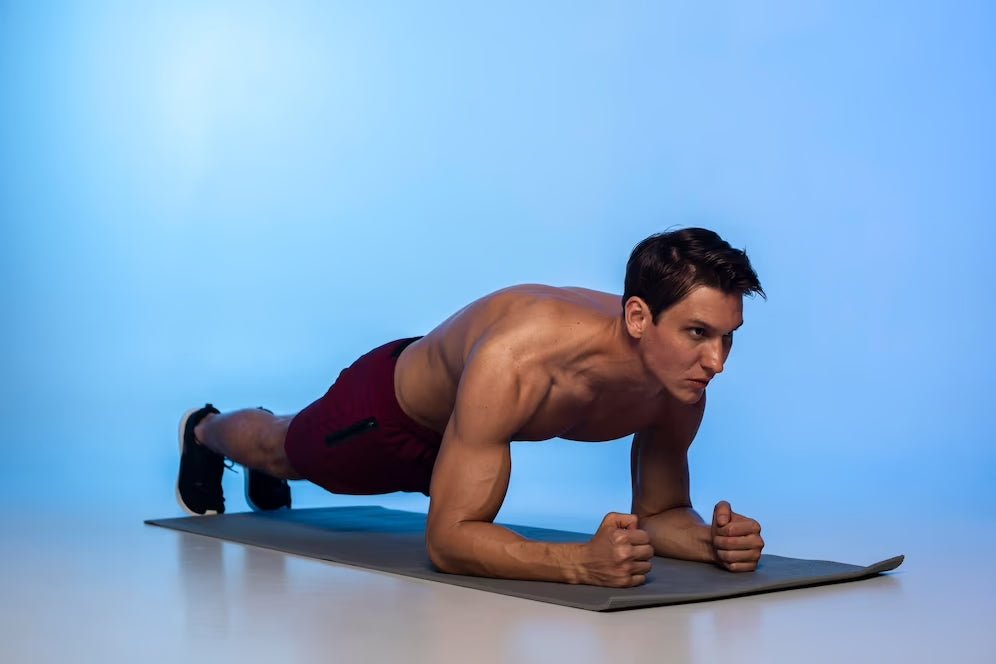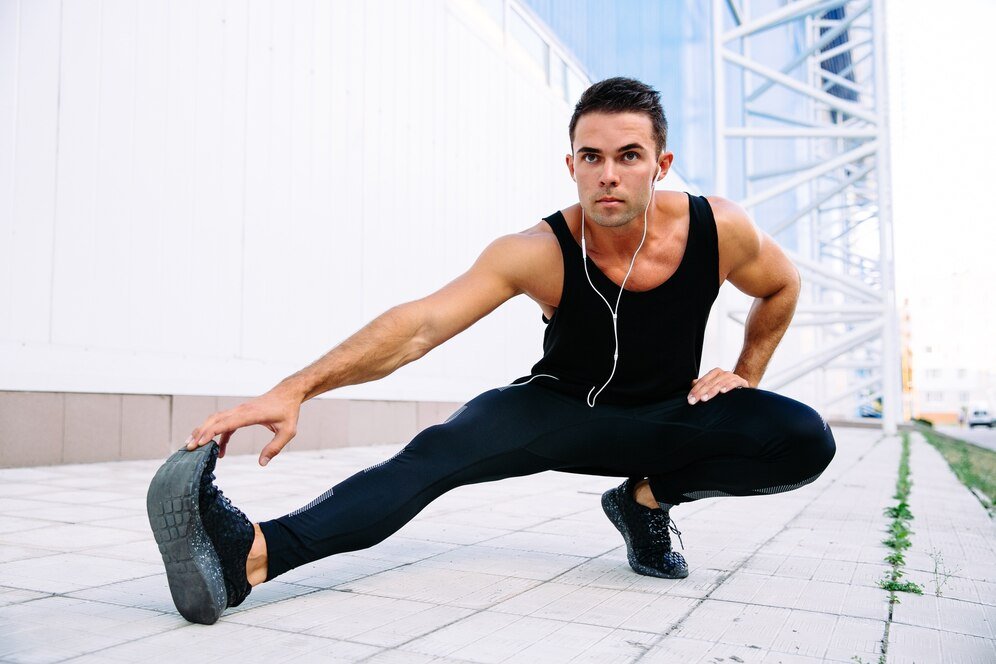A well-defined set of shoulders enhances your overall physique and signifies strength and power.
The front deltoids often take center stage among the three deltoid muscle heads, contributing significantly to the coveted V-taper look.
Whether you're an aspiring bodybuilder, a fitness enthusiast, or someone seeking a balanced upper body, targeting your front delts is a must.
How about we present some of the best front delt exercises to start performing for optimal results?
Let’s get going:
Best Front Delt Workouts For Mass
Listed below are the best workouts that are specifically targeted for front delts:
1. Barbell Overhead Press

The Barbell Overhead Press stands as a cornerstone of shoulder strength training, delivering a comprehensive array of benefits.
This compound shoulder movement places significant emphasis on the anterior deltoid while also engaging the lateral deltoids, posterior deltoids, triceps, and upper back muscles.
By lifting the barbell overhead in a controlled manner, you promote muscle growth, enhanced definition, and functional upper body strength that can translate into everyday activities and athletic endeavors.
Step-By-Step Guide
- Stand with your feet hip-width apart and position the barbell on a squat rack or a power rack at about chest height. Load the desired weight on the bar.
- Approach the barbell and grip it slightly wider than shoulder-width apart with an overhand grip. Your palms should be facing forward, and your elbows should be pointing slightly forward.
- Unrack the barbell by lifting it off the rack and bringing it to shoulder height. Brace your core, squeeze your glutes, and maintain a neutral spine.
- Take a deep breath and press the barbell overhead by fully extending your arms. Keep your wrists in a straight line with your forearms.
- As you press, push your head slightly forward to create a path for the barbell to move without hitting your face.
- Once the barbell is overhead, lock out your elbows and pause briefly at the top.
- Lower the barbell back to shoulder height with controlled movement. Avoid flaring your elbows excessively; they should stay relatively close to your body.
Tips & Cues
- Keep your core engaged throughout the movement to maintain stability.
- Avoid leaning back excessively; maintain a neutral spine.
- Focus on controlled breathing: inhale as you lower the bar and exhale as you press it overhead.
- Start with a lighter weight to ensure proper form before increasing the load.
2. Cable Shoulder Press

The Cable Shoulder Press emerges as a dynamic front delt exercise that capitalizes on constant tension throughout the movement.
By maintaining resistance in both the concentric and eccentric phases, this exercise offers targeted stimulation to the deltoid muscles, cultivating balanced development across the shoulder complex.
As you press the handle upwards against the cable, your muscles engage to counteract the resistance, culminating in heightened muscle activation.
This exercise also accentuates muscle control and stability due to the consistent tension imposed by the cable, contributing to improved mind-muscle connection and refined training outcomes.
Step-By-Step Guide
- Set up a cable machine with a handle attachment at the highest pulley position.
- Stand facing the machine, about a step away, with your feet shoulder-width apart.
- Grasp the handle with an overhand grip, and hold it at shoulder height with your elbows bent at 90 degrees.
- Step back slightly to create tension on the cable.
- Press the handle upward by extending your arms fully.
- Hold the peak contraction for a moment, feeling the squeeze in your shoulders.
- Slowly lower the handle back to the starting position.
- Repeat for the desired number of reps.
Tips & Cues
- Maintain a slight bend in your knees throughout the exercise.
- Keep your core engaged to stabilize your body.
- Focus on a smooth and controlled movement, both during the press and the lowering phase.
3. Dumbbell Front Raise

This front delt workout hones in on muscular definition and enhances symmetry, making it a valuable addition to any shoulder-focused routine.
The Dumbbell Front Raise shines a spotlight on the anterior deltoids, facilitating isolated and precise training of this muscle group.
By lifting the dumbbells forward to shoulder height while maintaining a slight bend in the elbows, you effectively target the front of the shoulders, resulting in a well-rounded and aesthetically pleasing shoulder appearance.
Step-By-Step Guide
- Stand upright with a dumbbell in each hand, arms fully extended by your sides, and palms facing your body.
- Keep a slight bend in your elbows as you lift the dumbbells forward.
- Raise the dumbbells to shoulder height, making sure not to lift them higher than parallel to the ground.
- Pause briefly at the top, feeling the contraction in your front deltoids.
- Lower the dumbbells back down to the starting position in a controlled manner.
- Repeat for the desired number of reps.
Tips & Cues
- Keep your core engaged to stabilize your body.
- Focus on lifting the dumbbells with your shoulder muscles, not by using momentum.
- Avoid swinging your body or arching your back.
4. Handstand Push-Up

This bodyweight exercise places the shoulders in an upside-down position, igniting the deltoids, triceps, and core muscles as they collaborate to lift and lower the body.
As you push through the palms to extend the arms and elevate your body, the shoulders bear the brunt of the load, leading to considerable strength gains.
Beyond muscle development, the Handstand Push-Up is one of the advanced front delt workouts that sharpens balance, coordination, and proprioception, fostering heightened body awareness and control.
Step-By-Step Guide
- Begin in a handstand position against a wall. Your hands should be placed slightly wider than shoulder-width apart.
- Lower your body by bending your elbows, bringing your head towards the ground.
- Continue descending until your head lightly touches the ground or is close to it.
- Push through your palms to extend your arms, lifting your body back up to the starting position.
- Maintain a straight body line throughout the movement.
Tips & Cues
- Keep your core tight to maintain a stable handstand position.
- Use controlled movements and avoid sudden drops or jerky motions.
- If you're a beginner, practice against a wall or have a spotter assist you.
5. Behind-The-Neck Press

The Behind-The-Neck Press emerges as a specialized exercise that targets the middle and rear deltoids, promoting a well-rounded and balanced shoulder development.
As you press the barbell upward from behind the neck, the middle and rear deltoids engage to execute the movement, contributing to improved shoulder aesthetics and functionality.
This exercise also encourages shoulder mobility and flexibility when performed with proper form, making it a valuable addition to a comprehensive shoulder workout routine.
Step-By-Step Guide
- Stand with your feet shoulder-width apart and the barbell resting on your upper traps behind your head.
- Grip the barbell with an overhand grip, slightly wider than shoulder-width apart.
- Unrack the barbell by lifting it off the rack and stabilizing it behind your head.
- Take a deep breath and press the barbell upward by extending your arms fully.
- As you press, ensure that the barbell moves in a straight line, avoiding excessive forward or backward lean.
- Lock out your elbows at the top of the movement and hold briefly.
- Lower the barbell back to the starting position behind your head in a controlled manner.
- Repeat for the desired number of reps.
Tips & Cues
- Maintain a slight bend in your knees for stability.
- Keep your core engaged to support your spine and maintain balance.
- Ensure a comfortable grip on the barbell, avoiding excessive strain on your wrists and shoulders.
6. Landmine Press

The Landmine Press is an effective exercise for targeting the front deltoids, among other muscle groups.
By utilizing a barbell anchored at one end, this movement engages the front delts as you press the weight away from your chest.
The exercise not only helps in developing shoulder strength and size but also recruits the triceps, upper chest, and core for stability.
The unique angled pressing motion of the Landmine Press can be less stressful on the shoulder joints compared to traditional overhead presses, making it a valuable addition to a shoulder training regimen.
Step-By-Step Guide:
- Place one end of a barbell into a landmine attachment or securely into a corner.
- Load the opposite end with an appropriate weight.
- Stand facing the weighted end of the barbell.
- Grasp the barbell with both hands using an overhand grip, hands positioned at chest level.
- Assume a shoulder-width stance with your knees slightly bent for stability.
- Press the barbell away from your chest, extending your arms fully.
- Keep your core engaged and maintain a stable stance throughout the movement.
- Lower the barbell back to the starting position with control.
Tips & Cues
- Ensure smooth, controlled movements to avoid strain.
- Start with a light weight to focus on form before increasing the load.
7. Front Plate Raise

The Front Plate Raise is a straightforward yet highly effective isolation exercise specifically targeting the front deltoids.
Holding a weight plate in front of your thighs and lifting it directly in front of you engages the front delts in a focused manner.
This exercise enhances shoulder definition and strength while involving the upper chest and trapezius muscles. Since the movement is relatively simple, it allows for a concentrated effort on the front delts, making it suitable for both beginners and advanced lifters.
Step-By-Step Guide:
- Stand with your feet shoulder-width apart.
- Hold a weight plate (5 to 25 pounds depending on your strength) with both hands in front of your thighs.
- Hold the weight plate with an overhand grip, palms facing down.
- Keep a slight bend in your knees for stability.
- Lift the weight plate directly in front of you, extending your arms straight out.
- Aim to bring the plate to shoulder height, keeping your arms extended.
Tips & Cues
- Keep a slight bend in your elbows to avoid locking them.
- Control the movement and avoid using momentum.
- Focus on engaging your front delts throughout the exercise.
Concluding Remarks
Your front deltoids play a pivotal role not only in aesthetics but also in functional strength.
Whether you're lifting, pushing, or even carrying out daily tasks, a robust set of front delts can provide the support you need.
Integrating a mix of compound movements and targeted isolation front delt exercises'll create a symphony of growth that resonates through your entire shoulder complex.



